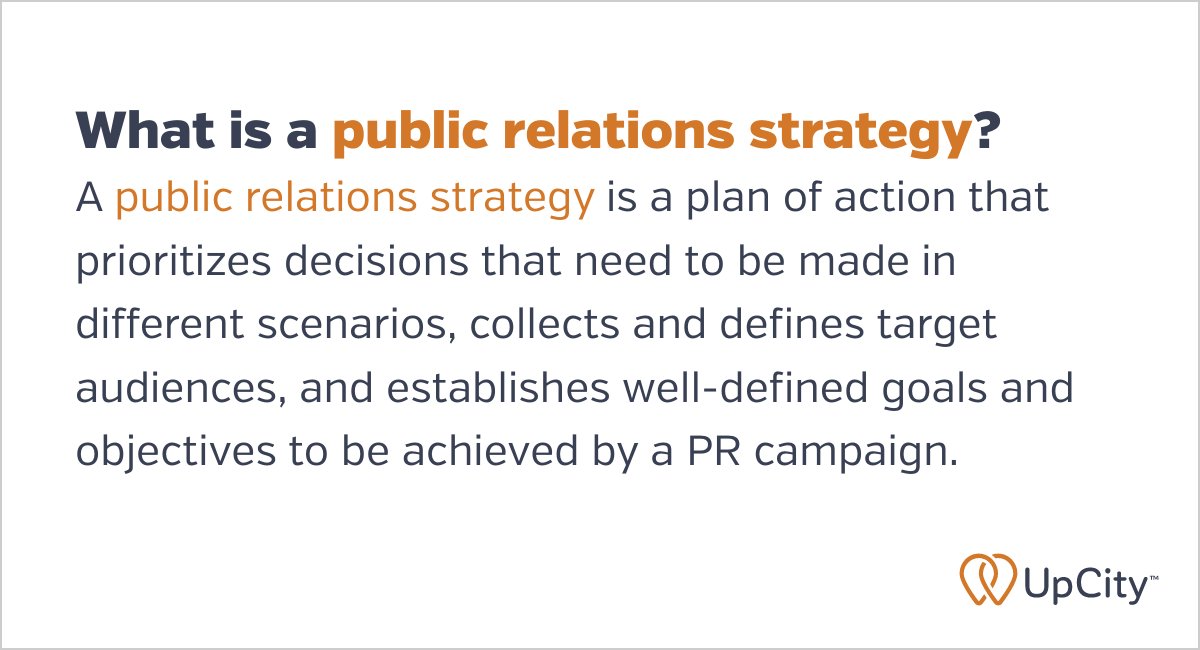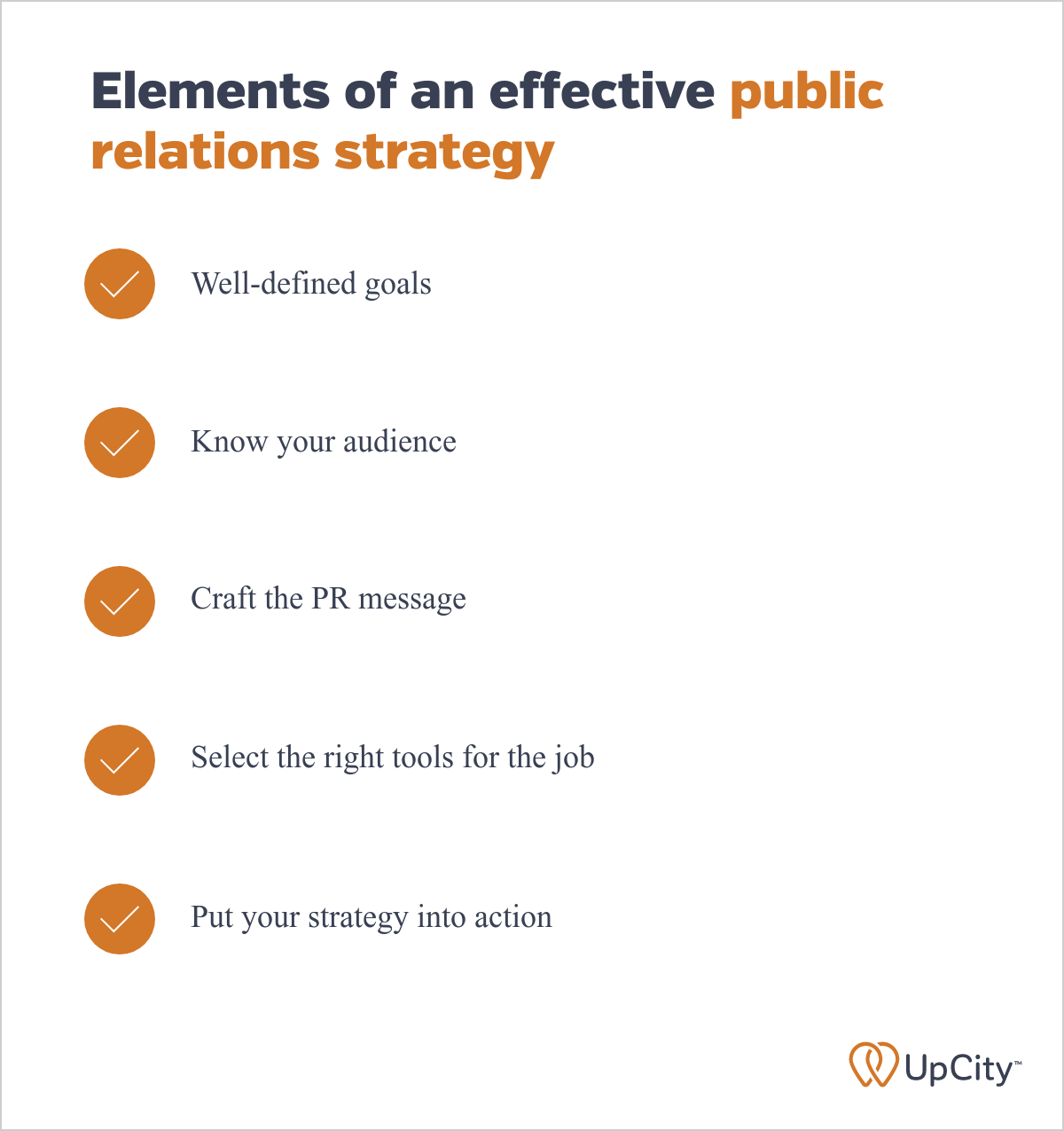Discover PR tactics and examples for small business owners.
Public relations is often only thought of when there has been a business crisis that threatens to impact brand image and customer loyalty. But the truth is that PR tactics and PR strategies are not only necessary but massively beneficial for businesses large and small. PR tactics have been successfully implemented for decades to help brands and organizations launch new products and drive new business, and effective public relations strategies can do the same for SMBs and mid-size companies, too. [1]
Here we’ll look beyond the misperceptions about public relations and put together a guide that offers a better understanding of just what PR can do for small businesses, several types of public relations strategies, examples of effective PR strategies, and some tips for considering how PR tactics can be applied to help your business grow and succeed.
Public relations strategy vs. PR tactics
A public relations strategy is a plan of action that prioritizes decisions that need to be made in different scenarios, collects and defines target audiences, and establishes well-defined goals and objectives to be achieved by a PR campaign. PR tactics are different, as they are the specific actions that are taken in order to put the plan into action and achieve necessary goals.

If some of this sounds familiar, it should, as several of these steps are also undertaken in developing your marketing strategy. But within the realm of public relations, PR strategy both looks and functions in a different way. While many marketing goals are somewhat easy to measure, PR tactics and goals can be more difficult to evaluate. Perhaps you are looking to improve your brand image or raise awareness for your company and products or services. Both of these are often goals of an overall marketing strategy, but public relations achieves them in ways that are slightly different from marketing tactics.
There are also aspects of a PR strategy that are unrelated to traditional marketing efforts. Perhaps your company wants to attract new investors for a startup or product launch, or you want to gain the attention of experts and get them talking about what you have to offer. [2] These would be examples where PR strategy and tactics both differ from marketing.
Public relations and marketing cannot be separated completely, though, and a PR strategy should support marketing efforts while functioning on its own to address the issues and achieve the goals that your business has identified.
Essential elements of a PR strategy and what makes them effective
No matter what your goals are or what size your company is, there are some crucial elements that are and should be common to all PR strategies. Here are a few of the most important components that you absolutely need to consider as a part of your public relations strategies.

Well-defined goals
No plan can succeed without first understanding the goals. And your PR strategy is no different. Some common goals include combating negative press, improving brand reputation, growing consumer awareness of the brand or product, and establishing the brand as a trustworthy source of information and expertise. But there are countless other examples of PR goals. Just make sure that as you begin developing your strategy, you kick things off by defining the goals you hope to achieve.
Know your audience
As with your digital marketing strategy, your PR strategy needs a well-defined audience. This includes not only current customers and the data you have on them, but also specific details about intended audiences and prospects. Your audience for a specific PR campaign or effort will be defined by the goals you have set in the first step, which should help you hone in on who you want to reach and how.
Craft the PR message
Now that you have clear goals and a good understanding of the intended audience, you’re ready to develop the specific messaging. If your PR campaign is linked to or in support of ongoing marketing efforts, you can begin with the marketing messaging to adapt and modify it for your public relations purposes. If this is strictly a PR campaign, then you should begin crafting and refining the message based on audience, intent, and outlets you will be using.
Select the right tools for the job
Depending on your goals, you may need or benefit from specific PR tools. [3] For example, if you are engaging with the press or influencers, there are sites, agencies, and tools that can help you pitch your message, develop contacts, and expand your reach through larger channels. There are also tools to help you monitor your brand’s mentions online, including as part of your social media analytics process. You’ll also want to be able to monitor media mentions and other channels, possibly with reputation management software.
Your selection of tools should also include any analytics tools you plan to use, taking into account your established PR goals and how you want to analyze, evaluate, and understand them.
Put your strategy into action
Once you have your strategy developed and know which tools, outlets, or PR channels you will be incorporating, you are ready to get things rolling. This is where you’ll incorporate the PR tactics you have chosen, including:
- Press releases
- Social media
- Expert content marketing
- Video presentations from executives and experts
- Influencers
- In-person events and/or sponsorship
- Print/billboard advertising
- Media contacts and journalists
Types of PR strategies
Among the many different PR strategies you might choose from, there are some common examples that any business will need from time to time. And you may want to consider having some of the crafted before you need them. They include:
Crisis communications strategy
Crisis management or response strategies aim to minimize negative impacts on the business, reassure current and future customers, and of course address and correct the issue(s) that led to the crisis. PR crisis management will also be aimed at protecting the brand and setting the right tone for all communications.
Product launch PR strategy
It’s not enough to put a new product or service out into the world; you also have to make sure that people know about it. And a product launch PR strategy is designed to do just that, using a blend of tactics to reach your audience with relevant information and opportunity to learn about the product and your brand.
Reputation management campaign
Whether combating negative press or negative reviews, or simply trying to elevate your brand’s position within the marketplace, a reputation management campaign can utilize PR tactics to establish credibility and grow your audience simultaneously.
Sales boost campaign
Not unlike a marketing campaign, a PR sales campaign would have a strategy built around driving purchases and qualified leads. Again, this strategy would utilize a blend of PR tactics, and would certainly function in concert with your marketing strategy as well.
PR strategy examples
There are countless examples of great, well-executed PR strategies and campaigns, but here are just a few standout favorites.
The ALS Association Ice Bucket Challenge
No matter how many years ago this campaign occurred, it comes up again and again as one of the truly great examples of an effective PR campaign. It raised not only awareness but substantial donations for ALS research, it was interactive, it leveraged social media in a way that few nonprofits had up to that point, and it just worked.
Smokey the Bear
From PR strategy to cultural icon? It happened when the U.S. Forest Service and the Ad Council created the long-running and incredibly successful “Smokey Bear” campaign. [4]
Dove’s #TheSelfieTalk Campaign
Aimed at countering the negative impacts of social media and the pressures that young girls face around their appearance, Dove tackled the issue head-on and promoted online conversation about unrealistic beauty standards, the negative effects of social media culture, and the need for more positive images and impacts for women of all ages. [5]
How can you leverage public relations agencies?
There are dozens, and maybe even hundreds, of great examples of PR strategies that have been not only effective but have had a long-lasting impact. And one thing that they all have in common is that they were not created by a small team working by themselves. Each of the campaigns above benefited from outside advice, expertise, and energy, and the same can be true for any small business.
Whether you are wondering just what is a PR strategy that could work for your business, or you want to implement effective public relations strategies but don’t have the resources, UpCity’s Public Relations Providers directory features dozens of firms for you to contact. All highly rated and experienced, there are numerous PR experts and providers who can consult with you on developing, implementing, and evaluating PR strategies that make the most sense for your goals.
Implement your public relations strategies and tactics today
There are countless challenges facing small business owners each day, and public relations is among the most important. From growing your brand to managing a crisis, PR can be just as important to your company as accounting, HR, and IT.
Whether your company is looking to rebrand after a crisis or you want to explore how personal branding can be utilized to improve your marketing and PR performance, there is a wealth of information available in our UpCity resources. You can even go back to the basics and learn how the press release is still an effective and important tool in your PR strategy.
And don’t hesitate to contact some of the PR providers in our directory listed above. Even if you aren’t sure where to get started with your public relations strategies and tactics, the experts found in the directory can offer guidance, suggestions, and decades of expertise, all centered around your business goals.
Sources
- Public Relations for Small Businesses: Tactics & Tips, Capterra
- PR Strategy in 2024: The Definitive Guide, PRLab
- DIY PR: 11 Public Relations Solutions for Small Businesses, Business News Daily
- Story of Smokey – About the Campaign, Smokey Bear
- The Selfie Talk: Social Media & Self-Esteem, Dove

